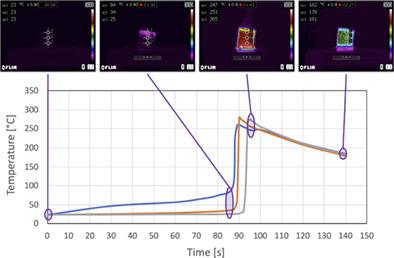当前位置:
X-MOL 学术
›
Polym. Int.
›
论文详情
Our official English website, www.x-mol.net, welcomes your feedback! (Note: you will need to create a separate account there.)
Radical photoinduced cationic frontal polymerization in porous media
Polymer International ( IF 3.2 ) Pub Date : 2020-11-25 , DOI: 10.1002/pi.6156 Daniele Maugeri 1, 2 , Marco Sangermano 2 , Yves Leterrier 1
Polymer International ( IF 3.2 ) Pub Date : 2020-11-25 , DOI: 10.1002/pi.6156 Daniele Maugeri 1, 2 , Marco Sangermano 2 , Yves Leterrier 1
Affiliation

|
Two different interpenetrating phase composites were produced using a radical photoinduced cationic frontal polymerization process. The composites were based on polyurethane (PU) and aluminium open‐cell foams impregnated with a formulation of a cycloaliphatic epoxy with different concentrations of a cationic photoinitiator and a thermal initiator. The influence of both types of initiators on the frontal polymerization features was systematically evaluated for the PU foam. It was found to occur only when the concentration of both initiators was greater than 0.5 wt%, leading to full conversion of the epoxy in the whole volume of the 15 mm thick composite samples within less than 100 s. The maximum temperature reached by the propagation front was in the range 275–305 °C depending on the type of formulation, leading to pores in the epoxy phase and extensive degradation of the PU phase. In the case of the opaque aluminium foam, an additional layer of pure resin was required on the UV‐exposed surface, which corresponded to a critical mass of a few grams to ensure sufficient heat generation and trigger the front propagation. © 2020 Society of Chemical Industry
中文翻译:

多孔介质中自由基光诱导的阳离子前沿聚合
使用自由基光诱导的阳离子正面聚合工艺生产了两种不同的互穿相复合材料。该复合材料基于聚氨酯(PU)和铝开孔泡沫塑料,并浸渍了脂环族环氧配方,并带有不同浓度的阳离子光引发剂和热引发剂。对于聚氨酯泡沫,系统地评估了两种类型引发剂对正面聚合特性的影响。发现仅当两种引发剂的浓度均大于0.5 wt%时才会发生,从而导致在不到100 s的时间内,环氧树脂在15 mm厚复合材料样品的整个体积中完全转化。取决于制剂的类型,传播前沿达到的最高温度在275–305°C范围内,导致环氧相中出现孔洞,PU相大量降解。对于不透明的铝泡沫,需要在暴露于紫外线的表面上再加上一层纯树脂,这相当于几克的临界质量,以确保产生足够的热量并触发正面传播。©2020化学工业协会
更新日期:2020-11-25
中文翻译:

多孔介质中自由基光诱导的阳离子前沿聚合
使用自由基光诱导的阳离子正面聚合工艺生产了两种不同的互穿相复合材料。该复合材料基于聚氨酯(PU)和铝开孔泡沫塑料,并浸渍了脂环族环氧配方,并带有不同浓度的阳离子光引发剂和热引发剂。对于聚氨酯泡沫,系统地评估了两种类型引发剂对正面聚合特性的影响。发现仅当两种引发剂的浓度均大于0.5 wt%时才会发生,从而导致在不到100 s的时间内,环氧树脂在15 mm厚复合材料样品的整个体积中完全转化。取决于制剂的类型,传播前沿达到的最高温度在275–305°C范围内,导致环氧相中出现孔洞,PU相大量降解。对于不透明的铝泡沫,需要在暴露于紫外线的表面上再加上一层纯树脂,这相当于几克的临界质量,以确保产生足够的热量并触发正面传播。©2020化学工业协会



























 京公网安备 11010802027423号
京公网安备 11010802027423号